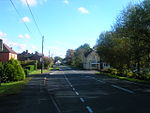Lyndhurst, Hampshire

Lyndhurst is a large village and civil parish situated in the New Forest National Park in Hampshire, England. Serving as the administrative capital of the New Forest, it is a popular tourist attraction, with many independent shops, art galleries, cafés, museums, pubs and hotels. The nearest city is Southampton, about nine miles (14 km) to the north-east. As of 2001 Lyndhurst had a population of 2,973, increasing to 3,029 at the 2011 Census. The name derives from an Old English name, comprising the words lind (lime tree) and hyrst (wooded hill). Known as the "Capital of the New Forest", Lyndhurst houses the New Forest District Council. The first mention of Lyndhurst was in the Domesday Book of 1086 under the name 'Linhest'. The Court of Verderers sits in the Kings House in Lyndhurst. The church of St. Michael and All Angels was built in the 1860s, and contains a fresco by Lord Leighton and stained-glass windows by Charles Kempe, William Morris, Edward Burne-Jones and others; Alice Liddell, the inspiration for Alice in Lewis Carroll's Alice's Adventures in Wonderland, is buried there. Glasshayes House (the former Lyndhurst Park Hotel) is the only surviving example of Sir Arthur Conan Doyle's architectural experimentation, and local folklore records Lyndhurst as the site of a Dragon-slaying, and as being haunted by the ghost of Richard Fitzgeorge de Stacpoole, 1st Duc de Stacpoole.
Excerpt from the Wikipedia article Lyndhurst, Hampshire (License: CC BY-SA 3.0, Authors, Images).Lyndhurst, Hampshire
Sandy Lane, New Forest
Geographical coordinates (GPS) Address Nearby Places Show on map
Geographical coordinates (GPS)
| Latitude | Longitude |
|---|---|
| N 50.87 ° | E -1.58 ° |
Address
Vernon Theatre
Sandy Lane
SO43 7DN New Forest
England, United Kingdom
Open on Google Maps











